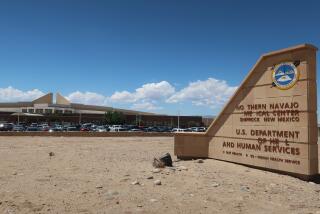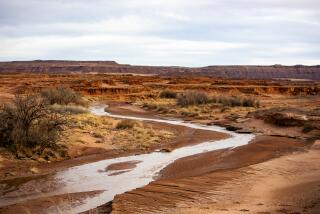Substandard Housing Remains Grim Reality for Many Navajos
- Share via
WINDOW ROCK, Ariz. — Wanda Segina and her four young children moved to the capital of the nation’s largest American Indian nation and promptly made one home improvement.
They dug an outhouse.
The family has no electricity, no running water and no sewer. They cook over an open fire, bathe in water hauled in by relatives. And although the trailer the family shares has three bedrooms, they sleep in one, huddling together in the cold.
“It’s a living hell. It’s a disaster for me as a mom,” said Segina, whose children are first-, second-, third- and fourth-graders at the local elementary school.
Segina’s living conditions are shared by thousands on the 4.8-million-acre Navajo Reservation, which sprawls across parts of Arizona, New Mexico and Utah, and throughout America’s Indian reservations, where housing is desperately scarce and often substandard.
The National American Indian Housing Council estimates U.S. reservations need 200,000 houses to alleviate overcrowding and replace inadequate dwellings.
More than half of the Navajo Reservation’s 56,372 homes lack complete plumbing, and a large percentage still use wood as the primary heating source, according to 1990 census figures.
“The country is moving so rapidly, we’re losing the chance to catch up,” said Navajo community development director Benjamin Jones.
Many American Indians are prevented from buying or living in adequate homes by a host of problems: high unemployment, few willing lenders, almost no private land and bureaucratic red tape.
Even basic knowledge about establishing good credit and applying for mortgages can trip up many would-be buyers, said Ernest Goatson, director of the Navajo Housing Service Department. “The [federal] housing program is more of a subsidy program than a homeownership program,” he said. “They see a house more as a giveaway.”
Tradition can also prove a major obstacle to modern housing, Jones said.
Navajos have historically lived far apart, with the rugged northern Arizona hills separating their corn crops and sheep from their neighbors. Their hogans, round dwellings built from native trees, were constructed by individual families.
“The way they saw their homes was spiritual, more of a cathedral, not property,” Jones said.
But for Navajos like Segina, for whom traditional dwellings are less important, money is an insurmountable obstacle.
Like Segina, roughly half of the Navajo Reservation’s 151,105 residents are jobless.
The single mother’s only source of income is child support and odd auto repair jobs, making it almost impossible for her to raise the $6,000 it would cost to connect her to a power line and the $8,000 it would cost for a water connection.
So instead, her four children do their homework by daylight or by a Coleman lantern at night. They drink canned milk and eat canned meat.
Even Navajos with steady jobs face obstacles to home ownership.
Jones holds a position in Navajo government roughly equivalent to a Cabinet post, but he lives in government housing he calls a “stall.”
“I’d be happy to buy a place if there was a place to buy, but there’s not,” he said.
Indian reservations are generally made up of trust land controlled by the federal government or family allotments, which can have dozens or even hundreds of owners. Such allotments create so much red tape and uncertainty for lending institutions that conventional mortgages are rarely granted.
Between 1992 and 1996, just 90 conventional loans were made in Indian country; half came from a tribally owned bank, said Christopher Boesen, executive director of the National American Indian Housing Council in Washington.
“This is the land America has forgotten,” said Scott Bray, who works with the Navajo community development division but is not a tribal member. “America has forgotten about these people.”
More to Read
Sign up for Essential California
The most important California stories and recommendations in your inbox every morning.
You may occasionally receive promotional content from the Los Angeles Times.










